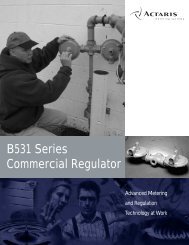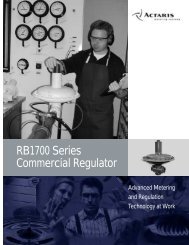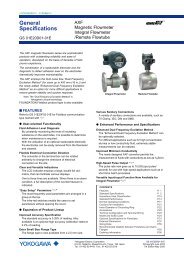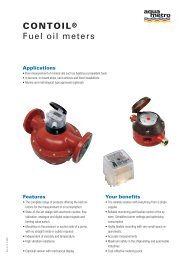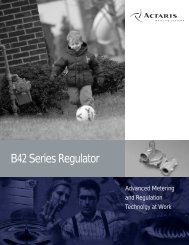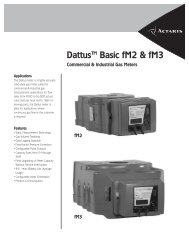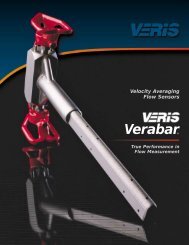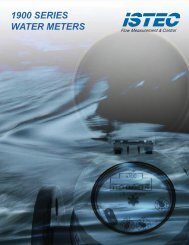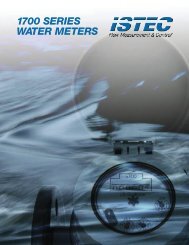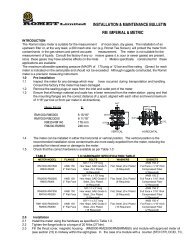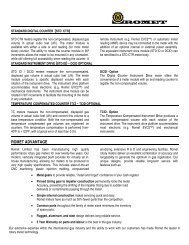User's Manual AXF Magnetic Flowmeter Integral ... - Yokogawa
User's Manual AXF Magnetic Flowmeter Integral ... - Yokogawa
User's Manual AXF Magnetic Flowmeter Integral ... - Yokogawa
Create successful ePaper yourself
Turn your PDF publications into a flip-book with our unique Google optimized e-Paper software.
8.2 FM<br />
(1) Technical Data<br />
*<strong>AXF</strong>002C – <strong>AXF</strong>400C<br />
Applicable Standard:<br />
FM3600, FM3610, FM3615,<br />
FM3810, ANSI/NEMA 250<br />
(<strong>Integral</strong> <strong>Flowmeter</strong>)<br />
Explosion proof for Class I, Division 1, Groups A,<br />
B, C & D.<br />
Dust-ignition proof for Class II/III, Division1,<br />
Groups E, F & G.<br />
Intrinsically safe (electrodes) for Class I, Division 1,<br />
Groups A, B, C & D.<br />
“SEAL ALL CONDUITS WITHIN 18 INCHES”<br />
“WHEN INSTALLED IN DIV. 2, SEALS NOT<br />
REQUIRED”<br />
Electrode Circuit Um: 250 Vac/dc<br />
Maximum power supply voltage: 250 Vac/130 Vdc<br />
Excitation Circuit: 140V max<br />
Enclosure: NEMA 4X<br />
Temperature Code: T6<br />
Refer to following table;<br />
Temperature<br />
Code<br />
T6<br />
T5<br />
T4<br />
T3<br />
Maximum Process<br />
Temperature<br />
+70°C (+158°F)<br />
+85°C (+185°F)<br />
+120°C (+248°F)<br />
+130°C (+266°F)<br />
Minimum Process<br />
Temperature<br />
–40°C (–40°F)<br />
–40°C (–40°F)<br />
–40°C (–40°F)<br />
–40°C (–40°F)<br />
T27-1.EPS<br />
Ambient Temp.: –40°C to +60°C (–40°F to +140°F)<br />
(Remote Flowtube)<br />
Explosion proof for Class I, Division 1, Groups A,<br />
B, C & D.<br />
Dust-ignition proof for Class II/III, Division1,<br />
Groups E, F & G.<br />
Intrinsically safe (electrodes) for Class I, Division 1,<br />
Groups A, B, C & D.<br />
“SEAL ALL CONDUITS WITHIN 18 INCHES”<br />
“WHEN INSTALLED IN DIV. 2, SEALS NOT<br />
REQUIRED”<br />
Electrode Circuit Um: 250 Vac/dc<br />
Excitation Circuit: 170V max<br />
Enclosure: NEMA 4X<br />
8. EXPLOSION PROTECTED TYPE INSTRUMENT<br />
Temperature Code: T6<br />
Refer to following table;<br />
Temperature<br />
Code<br />
T6<br />
T5<br />
T4<br />
T3<br />
Maximum Process<br />
Temperature<br />
+70°C (+158°F)<br />
+85°C (+185°F)<br />
+120°C (+248°F)<br />
+150°C (+302°F)<br />
Minimum Process<br />
Temperature<br />
–40°C (–40°F)<br />
–40°C (–40°F)<br />
–40°C (–40°F)<br />
–40°C (–40°F)<br />
T28-1_1.EPS<br />
Ambient Temp.: –40°C to +60°C (–40°F to +140°F)<br />
(2) Installation<br />
WARNING<br />
• All wiring shall comply with National Electrical<br />
Code ANSI/NFPA 70 and Local Electrical<br />
Code.<br />
• In hazardous locations, wiring to be in conduit<br />
as shown in Figure 8.2.1.<br />
•When installed in Division 2, “SEALS NOT<br />
REQUIRED”<br />
(3) Operation<br />
WARNING<br />
• “OPEN CIRCUIT BEFORE REMOVING COV-<br />
ERS.”<br />
• “SEALS ALL CONDUITS WITHIN 18 INCHES”<br />
in hazardous locations.<br />
•When installed in Division 2, “SEALS NOT<br />
REQUIRED”<br />
• Take care not to generate mechanical spark<br />
when access to the instrument and peripheral<br />
devices in hazardous locations.<br />
(4) Maintenance and Repair<br />
WARNING<br />
The instrument modification or parts replacement<br />
by other than authorized representative of<br />
<strong>Yokogawa</strong> Electric Corporation is prohibited and<br />
will void the approval of Factory Mutual Research<br />
Corporation.<br />
8-4<br />
IM 01E20D01-01E




